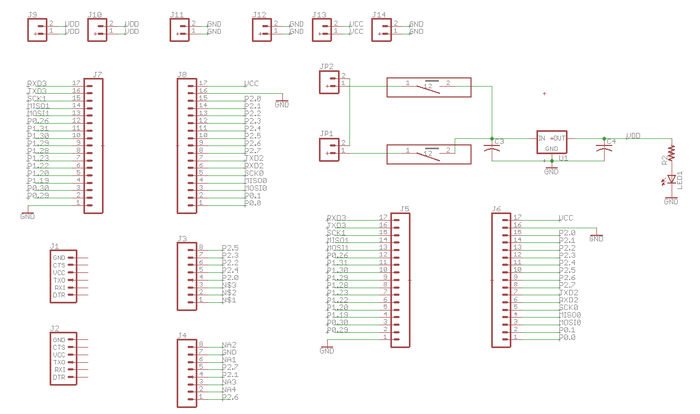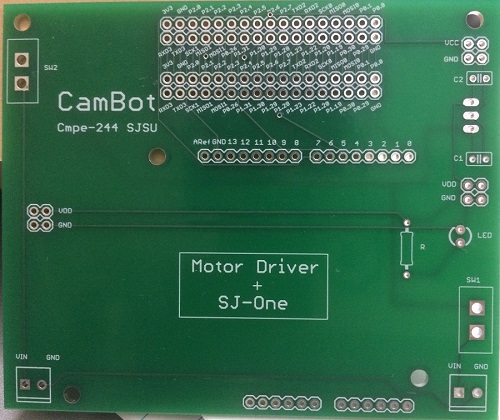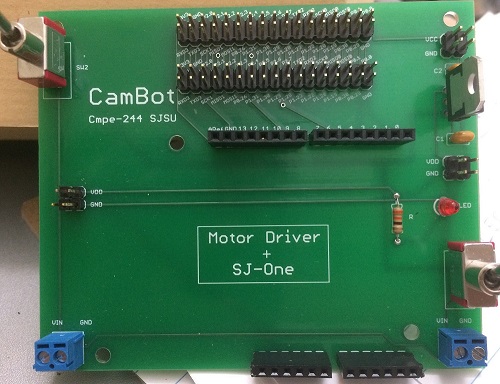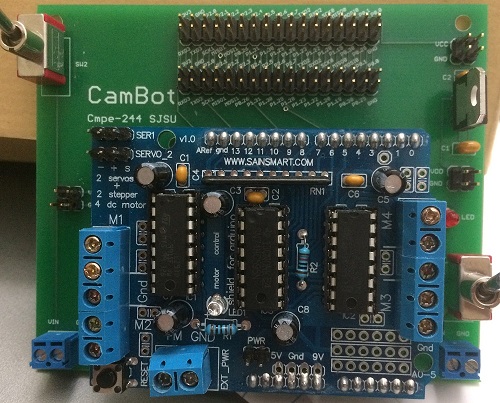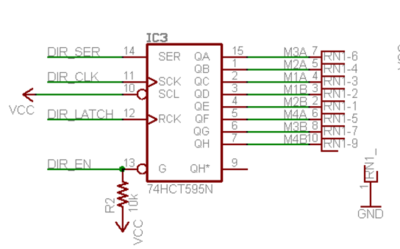Difference between revisions of "S17: CamBot"
Proj user16 (talk | contribs) (→Motor Shield) |
Proj user16 (talk | contribs) (→Motor Shield) |
||
| Line 176: | Line 176: | ||
[[File:CmpE244_S17_CamBot_MotorShield.png|400px|thumb|center|Motor Shield Schematic]] | [[File:CmpE244_S17_CamBot_MotorShield.png|400px|thumb|center|Motor Shield Schematic]] | ||
| + | |||
| + | |||
| + | ===== Motor Shield and SJOne Interface ===== | ||
| + | |||
| + | {| class="wikitable" | ||
| + | |- | ||
| + | ! scope="col"| Motor Shield Pin | ||
| + | ! scope="col"| SJOne Pin | ||
| + | |- | ||
| + | | 4 (CLK) | ||
| + | | P2.4 | ||
| + | |- | ||
| + | | 7 (EN) | ||
| + | | P2.5 | ||
| + | |- | ||
| + | | 8 (DATA) | ||
| + | | P2.6 | ||
| + | |- | ||
| + | | 12 (LATCH) | ||
| + | | P2.7 | ||
| + | |- | ||
| + | |} | ||
=== Software Design === | === Software Design === | ||
Revision as of 22:37, 21 May 2017
Contents
Grading Criteria
- How well is Software & Hardware Design described?
- How well can this report be used to reproduce this project?
- Code Quality
- Overall Report Quality:
- Software Block Diagrams
- Hardware Block Diagrams
- Schematic Quality
- Quality of technical challenges and solutions adopted.
CamBot
Abstract
The project aims to build a motorized camera holding bot that helps the photographers to create moving time-lapses across a landscape.The photographers can program the bot to move in a sequence of desired directions and capture the time-lapse. CamBot can slowly move over time to capture the time-lapse and also slowly change angles.
Objectives & Introduction
The project explores the GPIO and UART drivers in LPC1758 platform. CamBot is driven with the help of DC Motors whose PWM Signals are given by LPC1758. Since stepper motor moves in precise repeatable steps, it is best suited for applications requiring precise positioning. Precise increments of movement also allow for excellent control of rotational speed for process automation and robotics. Normal DC motors do not have much torque at low speeds. The sequence of directions for the CamBot is provided by a Bluetooth Application which sends the commands for specific movements.
Team Members & Responsibilities
- Spoorthi Mysore Shivakumar
- Goutam Madhukeshwar Hegde
- Chethan Palangotu Keshava
- Aajna Karki
Schedule
Team Schedule
| SI No. | Start Date | End Date | Task | Status | Actual Completion Date |
|---|---|---|---|---|---|
| 1 | 03/14/2017 | 03/21/2017 |
|
Completed | 03/21/2017 |
| 2 | 03/21/2017 | 03/28/2017 |
|
Completed | 03/28/2017 |
| 3 | 03/29/2017 | 04/04/2017 |
|
In Progress | |
| 4 | 04/05/2017 | 04/12/2017 |
|
In Progress | |
| 5 | 04/13/2017 | 04/18/2017 |
|
Not Started | |
| 6 | 04/19/2017 | 04/25/2017 |
|
Not Started | |
| 7 | 04/26/2017 | 05/02/2017 |
|
Not Started | |
| 8 | 05/03/2017 | 05/09/2017 |
|
Not Started | |
| 9 | 05/10/2017 | 05/15/2017 |
|
Not Started |
Parts List & Cost
Give a simple list of the cost of your project broken down by components. Do not write long stories here.
Design & Implementation
The design section can go over your hardware and software design. Organize this section using sub-sections that go over your design and implementation.
Hardware Design
Discuss your hardware design here. Show detailed schematics, and the interface here.
PCB Design
Eagle software is used for PCB design. The steps involved in the PCB design process are discussed below. 1. PCB Schematic Design: In the first step, we need to design a circuit using components available in Eagle library.Here two important things to keep in mind are: 1. The Electrical Characteristics: Based on our requirement of voltage or current rating, we select the components which are suitable for our board.For example, if we want to connect a switch to conduct 5A current, we should not select a switch with 2A current rating from the library because the copper width for 2A switch will not be able to conduct 5A current. 2. Components Selection: We need to carefully select the components here because each component has specific dimension as defined in their library.So once we convert this schematic into board layout, the size of the pads printed on the board depends on the component selection.We can't change the size if we select the library components.But there is a way we create our custom components with required electrical characteristics and dimensions.For our design, we used most of the parts from the Sparkfun library as it is very reliable and some of the parts which are not available in the library are created manually using Eagle.
Hardware Interface
The hardware components used in this project include:
- Motor Shield
- Stepper Motor
- DC Motor
- Bluetooth module.
Motor Shield
The Arduino motor shield is used in this project. It comprises of two L293D dual H-bridge motor driver ICs. It has four digital inputs which are in pairs. Each pair controls a motor. The operation can be explained with an example. If pin 7 is set low and pin 2 is set high, motor 1 is turned on. Reversing the inputs will reverse the motor. In order to conserve pins, the motor driver IC pins are wired to the outputs of 74HCT595N IC which is an 8-bit shift register. The data is fed in serially into this IC which then outputs the data in the parallel form.
The inputs to the shift register consists of:
- DIR_EN: Enable Input (Active Low)
- DIR_SER: Data Input
- DIR_CLK: Rising edge results in shifting in of the input data bit
- DIR_LATCH: Rising edge results in internal bits to be moved out as parallel data
Motor Shield and SJOne Interface
| Motor Shield Pin | SJOne Pin |
|---|---|
| 4 (CLK) | P2.4 |
| 7 (EN) | P2.5 |
| 8 (DATA) | P2.6 |
| 12 (LATCH) | P2.7 |
Software Design
Show your software design. For example, if you are designing an MP3 Player, show the tasks that you are using, and what they are doing at a high level. Do not show the details of the code. For example, do not show exact code, but you may show psuedocode and fragments of code. Keep in mind that you are showing DESIGN of your software, not the inner workings of it.
Implementation
This section includes implementation, but again, not the details, just the high level. For example, you can list the steps it takes to communicate over a sensor, or the steps needed to write a page of memory onto SPI Flash. You can include sub-sections for each of your component implementation.
Testing & Technical Challenges
Describe the challenges of your project. What advise would you give yourself or someone else if your project can be started from scratch again? Make a smooth transition to testing section and described what it took to test your project.
Include sub-sections that list out a problem and solution, such as:
My Issue #1
Discuss the issue and resolution.
Conclusion
Conclude your project here. You can recap your testing and problems. You should address the "so what" part here to indicate what you ultimately learnt from this project. How has this project increased your knowledge?
Project Video
Upload a video of your project and post the link here.
Project Source Code
References
Acknowledgement
Any acknowledgement that you may wish to provide can be included here.
References Used
List any references used in project.
Appendix
You can list the references you used.
